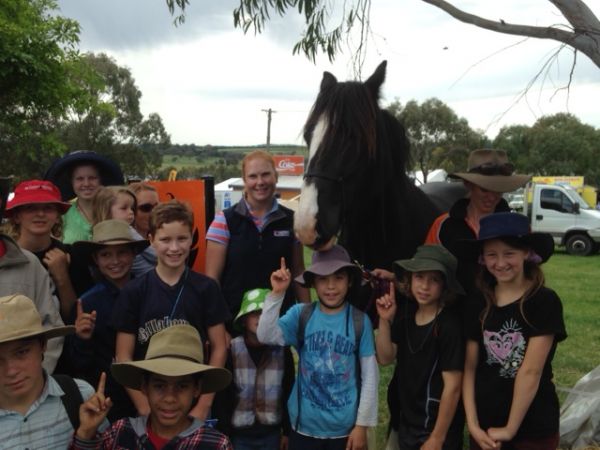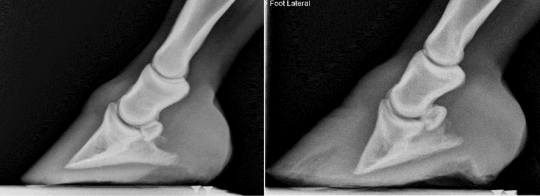 |
|

|
 |
October Large Animal News |
October 2014 |
 |
|
 |
In The Field
Our ever happy Kate Burnheim attended the Australian National Field Days at Borenore on Thursday and gave a talk about Equine heath and wellbeing. Kate the Horse was a great volunteer for Kate the Vet.
Kate fielded lots of questions from people but two of her favourites were from some school children who wanted to know, "Why are horses branded" and "Does it hurt the horse when you pull their mane"?
The keen questions came from the kids from The Village School ACMA, Parkes.
Kate will be giving talks each day at the field day. Great work Kate!
|
 |
 Kate and a great crowd at the ANFD.
|
 |
 |
|
|
|
|
|
 |
 |
02 Looking after your newborn foal |
 |
 |
|
 |
It probably felt like an eternity waiting for the birth of your foal, and now you want to do everything to make sure it remains healthy! Here are a few tips:
Nutrition and growth
Your newborn foal will be consuming 15-25% of its body weight in milk every day! So a 45kg foal will be drinking up 11L of milk and gaining weight at 0.5-1kg per day. Remember that as your foal grows it will need a gradual transition from an all milk diet to solid feed.
The introduction of solid food, often referred to as creep feeding, should begin after the foal's first month at around 0.5kg a day. The exact amount of feed will depend on the quality of other forages on offer. Throughout this period, it is important to monitor the body condition score of the foal and mare. If the foal is too light on for condition the feeding rates must be increased. It is also important to be looking for contracted tendons, angular limb deformities and lameness - these conditions can be significantly affected by unbalanced diets.
Vaccinations
Vaccinations are critical to protect against fatal diseases.
| Vaccination |
Age |
Disease |
Vaccine |
| 1st |
12 weeks |
Strangles
Tetanus |
Equivac 2 in 1 |
| 2nd |
14 weeks (2 wks after 1st) |
Strangles |
Equivac 2 in 1 or Equivac S |
| 3rd |
16 weeks (2 wks after 2nd) |
Strangles
Tetanus |
Equivac 2 in 1 |
Parasite control
Deworming starts at 6-8 weeks of age and repeats every 6 weeks after that. Remember other important aspects of managing parasites in your foal:
- Remove manure regularly from stables/yards/paddocks
- Harrow paddocks to break up manure and spell them during dry, hot weather
- Alternately graze paddocks with sheep or cattle
- Wash the perineum of pregnant mares prior to foaling to remove infective larvae
- Don’t feed horses on the ground – use a hay ring, and feed bins
- Remove bot eggs from horses' coats (flea combs are good for this job)
- Keep foals and weanlings separate from yearlings and older horses to minimize the foals’ exposure to ascarids and other parasites
|
 |
 |
|
 |
 |
03 Getting the most out of working dogs |
 |
 |
|
 |
For sheep farmers in particular, a good dog is one of your greatest assets. They make your day run efficiently and do what no-one else can to muster sheep. The modern sheep dog is the product of improved breeding, more sound training methods and better health care. This combination has produced athletic dogs similar to human Olympic athletes. To function at maximum capacity, these performance-bred and trained animals require specialised nutrition. Here are a few tips which will lead to the better performance of your dog.
Energy is key
Tired dogs cannot perform to the best of their ability. The best way to provide working dogs with energy is high-fat products. This is contrary to human athletes, who require high carbohydrate diets, as dogs burn fat more efficiently than humans. Dogs can actually sprint faster when fed increased fat. Fat is the ideal source of energy for dogs because it has over twice the energy per gram compared with carbohydrates or protein.
What about protein?
Protein gets a lot of conversation time when talking to athletes, and to a degree this is justified. There is substantial evidence that athletes require increased protein. Muscle size, density of blood vessels within muscle, and activity of enzymes, all made from amino acids, all increase with athletic training. For decades, soybeans and corn gluten have been used as a cheap source of protein, and while dogs survive on this they thrive on the amino acids provided by animal protein.
So, what is the best diet for working dogs?
- Nutrient dense diet with a high level of fat
- Animal based protein source, with high levels of crude protein
- More than just meat – meat is not a balanced diet
- Only feed <10% “treats” – table scraps, liver treats etc.
The diet of the average Australian working dog is poor, and we want to change this! Next time you’re in, discuss the nutritional needs of your dogs with us.
|
 |
 |
|
 |
 |
04 Consider microchipping your horse |
 |
 |
|
 |
Microchips provide a lifetime permanent identification number for your horse. The number is unique in the world. Microchips can be used for many different purposes: Proof of ownership, theft protection and recovery, disaster recovery, health certificates, medical records, farm management, event entries, travel, Registry ID, and sales documents. Here are some frequently asked questions about equine microchipping:
Where is it put and can it be removed? The chip is implanted in the nuchal ligament of horses. It cannot then be removed (without general anaesthesia and surgery).
What is involved in microchipping my horse? Microchipping is a simple procedure. Some horses require sedation and local anaesthetic, but others can be chipped without. The microchip is injected through a hypodermic needle into the horse's nuchal ligament along its neck. It only takes a couple of minutes to microchip a horse from set up to finish.
What age can I microchip my horse? Any age, from birth onwards.
If you would like your horse microchipped, give us a call.
|
 |
 |
|
 |
 |
05 Who killed Black Caviar's $5 million baby brother? |
 |
 |
As you have surely heard, Jimmy was euthanised after he developed severe laminitis. Laminitis refers to inflammation of the tissue connecting the hoof capsule to the pedal bone (bottom bone in the foot). A complicated and interrelated set of events occurs, which if severe enough can result in rotation and/or displacement of the pedal bone as depicted below. If not addressed the pedal bone can penetrate through the sole, a life ending injury.
 Figure 1 Normal foot Figure 2 Pedal bone rotation
Horses at Risk
- Horses grazing lush green pastures or on high grain diets
- Horses with a bacterial septicaemia (infection), particularly of the gut or uterus
- Horses with an unrelated lameness causing uneven weight bearing on the front feet (eg spider bite in Jimmy’s case)
- Horses who are overconditioned (fat)
- Horses with pituitary dysfunction (eg Cushing's Disease)
What might you see?
Horses with laminitis generally present with a moderate to severe forelimb lameness. Affected horses may stand with their forelimbs outstretched and their hindlimbs tucked under their abdomen to take more of their body weight. Other signs include weight shifting on their front feet, reluctance to walk on firm surfaces and increased time spent lying down.
What can your vet do?
We can identify the cause of laminitis, alleviate pain and inflammation, stabilise the pedal bone and implement management strategies to help reduce the chance of recurrence. We may also want to radiograph (x-ray) the feet to accurately assess the degree of damage and recommend corrective shoeing techniques to your farrier.
What can you do to prevent laminitis in your horse?
Work in conjunction with your veterinarian to ensure your horse is kept in a moderate condition score and nutrition is appropriate. Get their feet regularly trimmed by a qualified farrier and slowly introduce any dietary changes when required.
Horse Fact: Did you know that horses bear 75% of their body weight on their front feet?
|
 |
 |
|
|
|
|